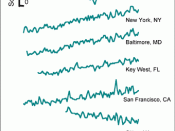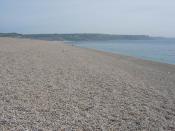It is very difficult to show how sea levels have changed more than 70,000 years ago. Beyond 70,000 years there were many rises and fall in sea levels due to the 17 major glacial shifts that we have had since they started 1.8 million years ago. Evidence for these fluctuations is hard to find, due to the fact that sea levels have ultimately risen, and covered up the evidence that would suggest these fluctuations.
However our last glacial period started around 70,000 years ago, and finished nearly 11,000 years ago. Since about 18,000 years it began to get warmer, causing ice to melt and sea levels to rise. At between 13000 and 11000 years ago there was another cold period, during which the sea levels fell and the ice advanced.
The Holocene is the name given to the period since the last ice advance, what we would call the ice age.
This "ice age" started around 11500 years ago and marked the final progression out of the Pleistocene, and the influence of large scale ice cover. Then a period of rapid sea level rise ensued between 11500 and 6000 years ago; this is known as the Holocene or Flandrian progression. Due to the fact that the vast majority of the Pleistocene ice had melted by 6000 years ago sea level fluctuations have been relatively slow since then. There is still much debate between glaciologists about how the sea levels changed during this 6000 year period.
The geographical distribution of relative sea level changes is very complex, but generally it reflects the proximity to areas close to maximum ice thickness. Thus places like Greenland, Iceland and Northern Canada are more influenced by a rise in land due to isostatic recovery. In contrast however places that were much further from any...


